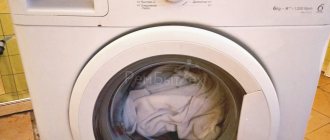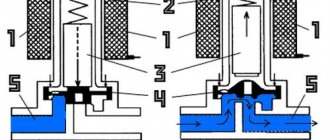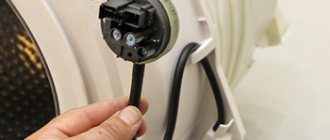An automatic washing machine is one of the most necessary household devices in a household. This is expensive equipment that is purchased for many years, and its breakdown can seriously hit the family budget. Therefore, it is worth understanding what causes various problems and what to do if the washing machine constantly drains water. Many problems can be easily fixed on your own, and knowledge will protect you from unscrupulous repairmen who inflate prices for repairs.
Incorrect or broken hose
The reason why the machine fills and drains water at the same time is that the hose is incorrectly positioned, broken or too low. In this case, the display shows an error code: LE, LC, E9, or LE1.
Such codes are deciphered as “self-draining”, “leakage”. If the machine is not equipped with a display, all wash indicators turn red, except for the cold mode. In devices equipped with an aquastop, a special “float” in the pan reacts to a leak, which immediately gives a signal to stop work.
It is possible that the connection between the hose and the sewer is not secure enough, especially if it has recently been unscrewed. The gasket may be worn out and needs to be replaced.
If such a problem occurs, it is necessary to inspect the floor for the presence of puddles, as well as the hose itself and the place where it is attached to the drain point.
Advice! Before washing, you should carefully inspect items for sharp objects. A small nail or pin in the pocket may fall out and damage the hose when draining.
Errors also occur when too much foam forms in the drum. The reasons are as follows:
- low-quality washing powder;
- overdose of detergent;
- powder not suitable for automatic machine.
The pressure switch reacts to this by displaying an error code.
Attention! If erroneous codes are displayed on the display of a new, newly connected machine, the issue is often resolved by a simple reboot.
Incorrect connection
When the washing machine fills with water and immediately drains, you should not rush to change the control unit or reflash the system, undertaking expensive repairs. The problem may be a low hose. In order to effectively eliminate such a malfunction, you need to imagine the process of adding and draining water in the machine.
The machine has a tank into which water is poured. At the bottom of the machine there is a pump, which is connected to the tank with a pipe. Through the same pump, water is pumped out of the machine. There is no plug in the hose through which the drain occurs that could hold water. Therefore, when connecting the drain hose to the sewer system, it must be at a height of at least 60–70 centimeters from the floor. Thus, the water will not flow out by gravity.
If the drain point is at floor level, the hose must be raised to a height of 60, or preferably 70 centimeters, secured in a loop and then lowered down to the drain hole. This will create a natural water seal and the water will stop draining. A special clamp for attaching the hose is often included in the design and is located on the back panel of the washing machine.
Attention! If the washing machine constantly fills and drains water, it is worth checking whether the hose is leaking at the connection point to the drainage point (sewer). A thin stream is enough so that the heating element does not have time to heat the water. The program “does not see” this error and sends a signal to constantly add water.
Forced drainage: why is it needed and how is it done?
In cases where the washing cycle has stopped and there is water inside, it is necessary to organize a forced drain. This needs to be done for several reasons:
- For further diagnostics and repairs, it is necessary that there is no water in the car.
- Leaving incompletely washed clothes in water for a long time can ruin things.
- It is not advisable to keep water in the car - it is not intended for long-term storage of liquid, and the called repairman will not come right away.
There are two relatively simple options for eliminating water:
- try to drain through the drain hose, completely lowering it to the floor, and redirecting the free end not into the sewer, but into a low bowl;
- through the emergency drain system, which is located on the front side below.
The video will show you how to force drain water:
Burnt out heating element
The reason why the machine takes in water and immediately drains it, and does not respond to pressing the buttons, may be a burnt-out heating element. In this case, you can turn off the device only by unplugging the cord from the outlet. Such problems occur when trying to use modes with heated water, while the “cold” wash remains working.
This means a malfunction of the heating element - heating element. The control unit does not detect the presence of hot water and does not proceed to the next washing stage after drawing water. This problem often occurs with older car models. In this case, the indicator of new models or “Indezit” equipped with a self-diagnosis system will display an error code.
You can check the correctness of the assumption using a multimeter:
- remove the back cover of the washing machine;
- remove the heating element by carefully prying it off with a screwdriver;
- put the multimeter in dialing mode;
- connect the ends of the multimeter to the two outermost protruding parts of the heating element.
If there is no response from the device, it means that the heating element is broken and must be replaced. You can purchase it at the store and easily install it yourself. The main thing is not to overtighten the rubber band during installation.
Additional causes of problems with heating elements:
- The presence of scale on the device due to hard water. Solution: you need to remove the heating element, soak it in vinegar and remove the plaque with a brush.
- Loose or oxidized electrical contacts. Solution: clean and tighten connections.
- Failure of adjustment in the thermostat responsible for measuring the water level and turning off the heating element. Solution: call a specialist.
Advice! In order for the heating element to serve for a long time, it is necessary not only to make a loop on the hose, raising it by 60 centimeters, but also to make the drain point itself higher by “extending” a piece of pipe to it. This will prevent unnecessary drainage of water, and the heating element will have to work with less load.
Pressostat malfunction
The washing machine fills an incomplete tank of water and immediately starts draining; the washing process does not start. The reason may lie in the closure of the pressure switch - a water level sensor that shows its quantity in the tank. Its breakdown can be determined by the following typical signs:
- water is constantly pumped into the drum;
- water level too high or too low;
- laundry is not wrung out properly;
- There is always a puddle of water at the bottom of the drum.
If the device gives an error without even starting the wash, the pressure switch may also be to blame: the tube is clogged and needs to be blown out.
By default, the pressure switch has three positions:
- full tank;
- empty tank;
- overflow
When you turn on the machine, the water supply valve starts, and the pressure switch, due to its malfunction, detects an overflow. After this, the upper part of the terminal closes and the water begins to drain. Upon subsequent switching on, the incorrect cycle is repeated. The solution is to replace the pressure switch. For this procedure, you must have the skill to use a screwdriver and pliers.
Important to remember! Each manufacturer of washing machines produces its own type of pressure switch. A sensor for “Samsung” will not fit “LG”, so the part is always replaced with a similar one or one recommended by the company.
Why does this happen?
If the washer fills with water and immediately empties the drum, this is immediately noticeable. Firstly, the cycle does not end at the appointed time. Secondly, noise is constantly heard from the machine without stopping the running sewage system. Thirdly, the laundry loaded into the machine remains dirty.
The following reasons lead to this situation:
- improper installation of the drain hose;
- sewer blockage;
- malfunction of the drain valve;
- faulty pressure switch;
- failure of the control board.
Modern Indesit models, if there is a problem with water collection, automatically turn off the cycle and display the corresponding error on the display.
The problem with water filling must be resolved immediately . Uncontrolled drainage negatively affects all elements of the drainage system, jeopardizing the pump, pipes and valves. There is also a high probability of leakage, short circuit and flooding of the apartment.
Intake valve failure
The inlet valve is a device that automatically controls the flow of water into the washing machine. Therefore, if it stops taking in water, it could mean the inlet valve is broken.
Intake valves are divided into several types:
- single-section (found in old-style devices);
- double;
- triples.
The latest types of valves are installed in electronically controlled machines.
A failed valve cannot be repaired and must be replaced with a new one. Before replacing, you should check it for blockages or using a multimeter. The resistance of the working valve will be 2–4 kOhm.
Unstable pressure in the water supply
Constantly changing water pressure can also cause problems with the washing machine, causing it to drain. The permissible pressure level is 1-4 bar. Values below or above these indicators indicate bursts and other problems with the water supply.
If the problem is of a general nature and has also arisen among neighbors, then it is advisable to contact service agencies. On a local scale, this may indicate flaws in the plumbing wiring or its defects. Namely:
- deposition of salts inside the pipe, which reduce its diameter and, accordingly, throughput;
- clogging of the water filter;
- presence of cracks.
The optimal solution in these situations is to replace the plumbing.
Important! Preference should be given to plastic products that are not prone to corrosion.
If holes have formed in plastic pipes, they can be filled with sealant or repaired using cold welding. Don’t forget to prevent the problem by regularly cleaning the filter.
Blockages
Clogging is one of the most common causes of washing machine failure. Over time, the filters become clogged and scale forms on them. Filters are divided into two types: drainage and inlet.
Note. Input filters break down especially often in machines.
Signs of blockages in the filter:
- unpleasant odor emanating from the device;
- slowly collecting water and draining it.
Step-by-step cleaning plan:
- input filter:
- turn off the water supply tap to the washing machine;
- disconnect and pull out the hose;
- pull out the filter;
- rinse the filter under strong water pressure;
- Insert the clean filter mesh back and press it along the edges;
- assemble the system and check for leaks.
- drain filter:
- open the lower hatch on the front panel;
- disconnect the hose;
- place the container and drain the remaining water;
- Pull out the filter in a circular motion;
- rinse the filter under running water;
- install the part back;
- turn the machine on to the “drain” mode and check for leaks.
To prevent blockages, you should clean the filters at least once every 2–3 months. The dirt trap socket, as well as the place where the filters are installed, must also be cleaned. Such simple care can extend the life of the machine for many years.
Preventive measures
To avoid these troubles, it is recommended that at the beginning of each wash, check that the washing machine is connected correctly, monitor the operation of the display in order to identify a possible problem in time, and also observe for some time the operating algorithm of the unit: whether it turns off prematurely and how often the pump turns on.
Important! Under no circumstances should the machine be left running without adult supervision.
Among other things, you need to remember the operating rules and regularly clean the filter from accumulated dirt. It is advisable to periodically wash the pipes with ordinary dishwashing detergent - it is less aggressive towards plastic than professional chemicals. It is also important to use high-quality powders and rinses that will not form deposits on the pipes.
Advice! If, nevertheless, one of the factory parts fails, it is better to replace it with a similar one, avoiding cheap spare parts. This will allow you to forget about the wear and tear of components for a long time.
What it is not recommended to do on your own
Anyone who has minimal skills in handling modern technology can handle minor repairs to a washing machine. But when it comes to failures in electronic hardware or software, the repair should be entrusted to a professional.
You cannot repair it yourself:
- complex electronic modules;
- relay;
- sensors
Almost every person is able to understand the simple causes of a washing machine malfunction and eliminate them. An attempt to fix a serious breakdown on your own entails unpleasant consequences both for the device and for the owner himself.











